
A carbohydrate is a biomolecule consisting of carbon (C), hydrogen (H) and oxygen (O) atoms, usually with a hydrogen–oxygen atom ratio of 2:1 and thus with the empirical formula Cm(H2O)n, which does not mean the H has covalent bonds with O. However, not all carbohydrates conform to this precise stoichiometric definition, nor are all chemicals that do conform to this definition automatically classified as carbohydrates.

Polysaccharides, or polycarbohydrates, are the most abundant carbohydrates found in food. They are long-chain polymeric carbohydrates composed of monosaccharide units bound together by glycosidic linkages. This carbohydrate can react with water (hydrolysis) using amylase enzymes as catalyst, which produces constituent sugars. They range in structure from linear to highly branched. Examples include storage polysaccharides such as starch, glycogen and galactogen and structural polysaccharides such as hemicellulose and chitin.

Fructose, or fruit sugar, is a ketonic simple sugar found in many plants, where it is often bonded to glucose to form the disaccharide sucrose. It is one of the three dietary monosaccharides, along with glucose and galactose, that are absorbed by the gut directly into the blood of the portal vein during digestion. The liver then converts most fructose and galactose into glucose for distribution in the bloodstream or deposition into glycogen.

Dietary fiber or roughage is the portion of plant-derived food that cannot be completely broken down by human digestive enzymes. Dietary fibers are diverse in chemical composition and can be grouped generally by their solubility, viscosity and fermentability which affect how fibers are processed in the body. Dietary fiber has two main subtypes: soluble fiber and insoluble fiber which are components of plant-based foods such as legumes, whole grains, cereals, vegetables, fruits, and nuts or seeds. A diet high in regular fiber consumption is generally associated with supporting health and lowering the risk of several diseases. Dietary fiber consists of non-starch polysaccharides and other plant components such as cellulose, resistant starch, resistant dextrins, inulin, lignins, chitins, pectins, beta-glucans, and oligosaccharides.

The glycemic (glycaemic) index is a number from 0 to 100 assigned to a food, with pure glucose arbitrarily given the value of 100, which represents the relative rise in the blood glucose level two hours after consuming that food. The GI of a specific food depends primarily on the quantity and type of carbohydrate it contains, but is also affected by the amount of entrapment of the carbohydrate molecules within the food, the fat and protein content of the food, the amount of organic acids in the food, and whether it is cooked and, if so, how it is cooked. GI tables, which list many types of foods and their GIs, are available. A food is considered to have a low GI if it is 55 or less; high GI if 70 or more; and mid-range GI if 56 to 69.
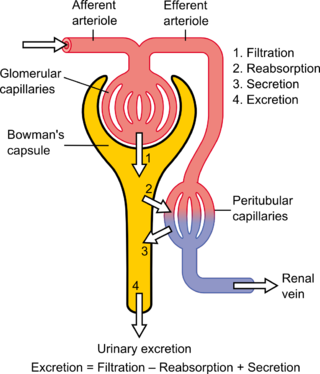
Renal functions include maintaining an acid–base balance; regulating fluid balance; regulating sodium, potassium, and other electrolytes; clearing toxins; absorption of glucose, amino acids, and other small molecules; regulation of blood pressure; production of various hormones, such as erythropoietin; and activation of vitamin D.

An oligosaccharide is a saccharide polymer containing a small number of monosaccharides. Oligosaccharides can have many functions including cell recognition and cell adhesion.

Fructose malabsorption, formerly named dietary fructose intolerance (DFI), is a digestive disorder in which absorption of fructose is impaired by deficient fructose carriers in the small intestine's enterocytes. This results in an increased concentration of fructose. Intolerance to fructose was first identified and reported in 1956.

Fructooligosaccharides (FOS) also sometimes called oligofructose or oligofructan, are oligosaccharide fructans, used as an alternative sweetener. FOS exhibits sweetness levels between 30 and 50 percent of sugar in commercially prepared syrups. It occurs naturally, and its commercial use emerged in the 1980s in response to demand for healthier and calorie-reduced foods.
Prebiotics are compounds in food that foster growth or activity of beneficial microorganisms such as bacteria and fungi. The most common environment concerning their effects on human health is the gastrointestinal tract, where prebiotics can alter the composition of organisms in the gut microbiome.

Polydextrose is a synthetic polymer of glucose. It is a food ingredient classified as soluble fiber by the US FDA as well as Health Canada, as of April 2013. It is frequently used to increase the dietary fiber content of food, to replace sugar, and to reduce calories and fat content. It is a multi-purpose food ingredient synthesized from dextrose (glucose), plus about 10 percent sorbitol and 1 percent citric acid. Its E number is E1200. The FDA approved it in 1981.
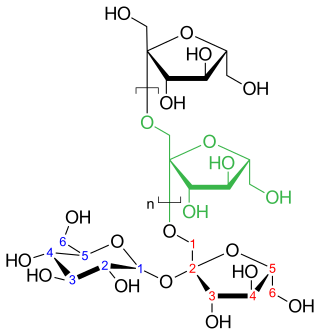
A fructan is a polymer of fructose molecules. Fructans with a short chain length are known as fructooligosaccharides. Fructans can be found in over 12% of the angiosperms including both monocots and dicots such as agave, artichokes, asparagus, leeks, garlic, onions, yacón, jícama, barley and wheat.
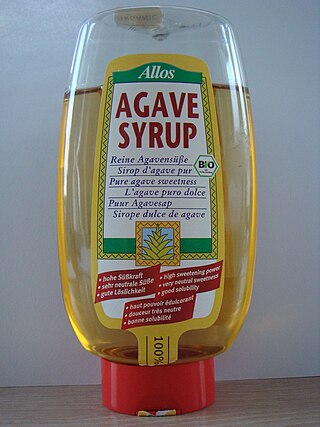
Agave syrup, also known as maguey syrup or agave nectar, is a sweetener commercially produced from several species of agave, including Agave tequilana and Agave salmiana. Blue-agave syrup contains 56% fructose as a sugar providing sweetening properties.
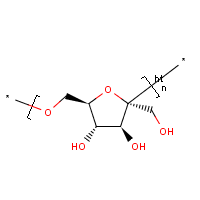
Levan is a naturally occurring fructan present in many plants and microorganisms. This polymer is made up of fructose, a monosaccharide sugar, connected by 2,6 beta glycosidic linkages. Levan can have both branched and linear structures of relatively low molecular weight. Branched levan forms a very small, sphere-like structure with basal chains 9 units long. The 2,1 branching allows methyl ethers to form and create a spherical shape. The ends of levan also tend to contain a glucosyl residue. Branched levan tends to be more stable than linear polysaccharides. However, the amount of branching and length of polymerization tends to vary among different species. The shortest levan is 6-kestose, a chain of two fructose molecules and a terminal glucose molecule.
FODMAPs or fermentable oligosaccharides, disaccharides, monosaccharides, and polyols are short-chain carbohydrates that are poorly absorbed in the small intestine and ferment in the colon. They include short-chain oligosaccharide polymers of fructose (fructans) and galactooligosaccharides, disaccharides (lactose), monosaccharides (fructose), and sugar alcohols (polyols), such as sorbitol, mannitol, xylitol, and maltitol. Most FODMAPs are naturally present in food and the human diet, but the polyols may be added artificially in commercially prepared foods and beverages.
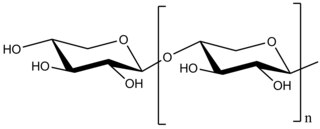
Xylooligosaccharides (XOS) are polymers of the sugar xylose. They are produced from the xylan fraction in plant fiber. Their C5 structure is fundamentally different from other prebiotics, which are based upon C6 sugars. Xylooligosaccharides have been commercially available since the 1980s, originally produced by Suntory in Japan. They have more recently become more widely available commercially, as technologies have advanced and production costs have fallen. Some enzymes from yeast can exclusively convert xylan into only xylooligosaccharides-DP-3 to 7.
Isomaltooligosaccharide (IMO) is a mixture of short-chain carbohydrates which has a digestion-resistant property. IMO is found naturally in some foods, as well as being manufactured commercially. The raw material used for manufacturing IMO is starch, which is enzymatically converted into a mixture of isomaltooligosaccharides.

Sinistrin is a naturally occurring sugar polymer or polysaccharide, also known as polyfructosane. It belongs to the fructan group, like inulin. As it is the case with similar substances, such as fructans or inulin, sinistrin acts as an energy storage molecule in plants.
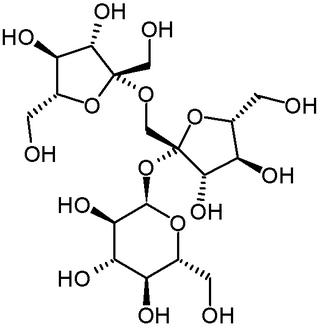
Kestose is a class of sugars that belongs to a group of fructooligosaccharides.
















